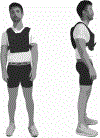Tibial compression during sustained walking with body borne load
- PMID: 35144087
- PMCID: PMC9020434
- DOI: 10.1016/j.jbiomech.2022.110969
Tibial compression during sustained walking with body borne load
Abstract
This study determined if sustained walking with body borne load increases tibial compression, and whether increases in tibial compression are related to vertical GRFs. Thirteen participants had tibial compression and vertical GRF measures quantified while walking at 1.3 m/s for 60 min with body borne load. Each tibial compression (maximum and impulse) and GRF measure (peak, impulse, impact peak and loading rate) were submitted to a RM ANOVA to test the main effect and interaction between load (0, 15, and 30 kg) and time (minute 0, 30 and 60), and correlation analyses determined the relation between tibial compression and vertical GRF measures for each load and time. Each tibial compression and GRF measure increased with the addition of body borne load (all: p < 0.001). Time impacted impact peak (p = 0.034) and loading rate (p = 0.017), but no other GRF or tibial compression measure (p > 0.05). Although both tibial compression and vertical GRFs increased with load, vertical GRF measures exhibited negligible to weak (r: -0.37 to 0.35), and weak to moderate (r: -0.62 to 0.59) relation with maximum and impulse of tibial compression with each body borne load. At each time point, GRF measures exhibited negligible to weak (r: -0.39 to 0.27), and weak to moderate (r: -0.53 to 0.65) relation with maximum and impulse of tibial compression, respectively. Walking with body borne load increased tibial compression, and may place compressive forces on the tibia that lead to stress fracture. But, increases in tibial compression may not stem from concurrent increases in vertical GRFs.
Keywords: Load carriage; Military; Musculoskeletal injury; Stress fracture.
Copyright © 2022 Elsevier Ltd. All rights reserved.
Conflict of interest statement
Conflict of Interest Disclosure
None
Figures







Similar articles
-
Ground reaction force metrics are not strongly correlated with tibial bone load when running across speeds and slopes: Implications for science, sport and wearable tech.PLoS One. 2019 Jan 17;14(1):e0210000. doi: 10.1371/journal.pone.0210000. eCollection 2019. PLoS One. 2019. PMID: 30653510 Free PMC article.
-
A cross-sectional study of the effects of load carriage on running characteristics and tibial mechanical stress: implications for stress-fracture injuries in women.BMC Musculoskelet Disord. 2017 Mar 23;18(1):125. doi: 10.1186/s12891-017-1481-9. BMC Musculoskelet Disord. 2017. PMID: 28330449 Free PMC article.
-
Relationships between tibial accelerations and ground reaction forces during walking with load carriage.J Biomech. 2023 Jul;156:111693. doi: 10.1016/j.jbiomech.2023.111693. Epub 2023 Jun 20. J Biomech. 2023. PMID: 37406568
-
Effects of load carriage on biomechanical variables associated with tibial stress fractures in running.Gait Posture. 2020 Mar;77:190-194. doi: 10.1016/j.gaitpost.2020.01.009. Epub 2020 Jan 28. Gait Posture. 2020. PMID: 32058282
-
Effects of prolonged walking with body borne load on knee adduction biomechanics.Gait Posture. 2021 Feb;84:192-197. doi: 10.1016/j.gaitpost.2020.12.004. Epub 2020 Dec 17. Gait Posture. 2021. PMID: 33360641 Free PMC article.
Cited by
-
Tibial Skeletal Adaptations in Male and Female Marine Corps Officer Candidates Undergoing 10 Weeks of Military Training.Calcif Tissue Int. 2025 Jan 9;116(1):27. doi: 10.1007/s00223-024-01339-5. Calcif Tissue Int. 2025. PMID: 39789346
-
Validation of Markerless Motion Capture for Soldier Movement Patterns Assessment Under Varying Body-Borne Loads.Ann Biomed Eng. 2025 Feb;53(2):358-370. doi: 10.1007/s10439-024-03622-w. Epub 2024 Oct 7. Ann Biomed Eng. 2025. PMID: 39375307
-
Effect of age on ankle biomechanics and tibial compression during stair descent.Gait Posture. 2024 Jul;112:140-146. doi: 10.1016/j.gaitpost.2024.05.015. Epub 2024 May 14. Gait Posture. 2024. PMID: 38781789 Free PMC article.
-
Measurement of the dynamic axial load-share ratio in vivo could indicate sufficient callus healing in external fixators.BMC Musculoskelet Disord. 2025 Feb 12;26(1):139. doi: 10.1186/s12891-025-08353-0. BMC Musculoskelet Disord. 2025. PMID: 39940030 Free PMC article.
-
Mechanical stability of the proximal tibia with different bone formations after plate removal in medial opening-wedge high tibial osteotomy: a finite element analysis.J Orthop Surg Res. 2024 Dec 19;19(1):850. doi: 10.1186/s13018-024-05373-9. J Orthop Surg Res. 2024. PMID: 39702331 Free PMC article.
References
-
- Birrell SA, Hooper RH, Haslam RA, 2007. The effect of military load carriage on ground reaction forces. Gait Posture 26, 611–614. - PubMed
-
- Burr DB, Milgrom C, Fyhrie D, Forwood M, Nyska M, Finestone A, Hoshaw S, Saiag E, Simkin A, 1996. In vivo measurement of human tibial strains during vigorous activity. Bone 18, 405–410. - PubMed
-
- Dempster WT, Gabel WC, Felts WJ, 1959. The anthropometry of the manual workspace for the seated subject. Am. J. Phys. Anthropol 17, 289–317. - PubMed
Publication types
MeSH terms
Grants and funding
LinkOut - more resources
Full Text Sources

